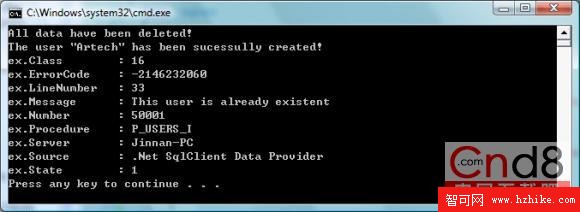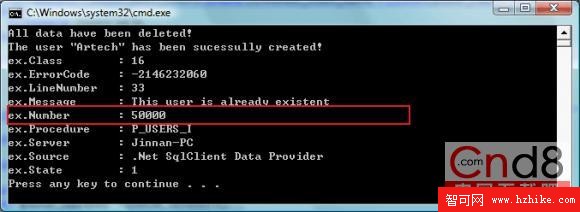六、SqlException
在上面一節中,我給出了一個完整的例子說明了:如何在將message定義在sys.messages中保證message的一致性和可維護性;如何在Stored procedure中使用RAISERROR將一個可預知的Error拋出;如何在Stored procedure中使用TRY/CATCH進行異常的捕捉;在Application如果處理從SQL Server拋出的Exception。實際上,SQL Server database Engine拋出、被我們的.Net最終捕獲的SqlException,我們通過SqlException的屬性可以得到Error的相關信息。下面是SqlException的屬性列表:
public SqlErrorCollection Errors { get; }
public int LineNumber { get; }
public int Number { get; }
public string Procedure { get; }
public string Server { get; }
public override string Source { get; }
public byte State { get; }
有了前面的內容作鋪墊,相信大家都知道每個屬性分別表示的什麼了吧。為了使大家對
stored procedure的Error和ADO.Net捕獲的Error的Mapping有一個更加清晰的認識。我們來寫一個Sample,我們沿用Create User的例子:
在stored procedure中,遇到重名通過RAISERROR拋出異常[在整篇文章中,使用到Error和Exception,大家可以看成是等效的]:
· Error Number:50001
· Severity:16
· State:1
· Message:This user is already existent
我們來修正一下CreateUser方法:
public static bool CreateUser(string userName)
{
string procedureName = "P_USERS_I";
Dictionary<string, object> parameters = new Dictionary<string, object>();
parameters.Add("user_id", Guid.NewGuid().ToString());
parameters.Add("user_name", userName);
try
{
ExecuteCommand(procedureName, parameters);
return true;
}
catch (SqlException ex)
{
Console.WriteLine("ex.Classt: {0}", ex.Class);
Console.WriteLine("ex.ErrorCodet: {0}", ex.ErrorCode);
Console.WriteLine("ex.LineNumbert: {0}", ex.LineNumber);
Console.WriteLine("ex.Messaget: {0}", ex.Message);
Console.WriteLine("ex.Numbert: {0}", ex.Number);
Console.WriteLine("ex.Proceduret: {0}", ex.Procedure);
Console.WriteLine("ex.Servert: {0}", ex.Server);
Console.WriteLine("ex.Sourcet: {0}", ex.Source);
Console.WriteLine("ex.Statet: {0}", ex.State);
return false;
}
}
在Main()中調用這個CreateUser():

在這裡我想特別說明一下SqlException.Number這個屬性,它代表Database中的Error number[或者是@@ERROR、imessage_id],不過當我們使用RAISERROR語句,如果我們指定的一個表示error message的字符串,ADO.Net捕獲的SqlException.Number這個屬性默認為50000。比如我們將Error number換成error message:
SET @error_message = ERROR_MESSAGE()
SET @error_serverity =ERROR_SEVERITY()
SET @error_state = ERROR_STATE()
RAISERROR(@error_message, @error_serverity,@error_state)
將會得到這樣的結果:

還有一點需要特別提醒得是,我們可以在調用RAISERROR加了一個WITH SETERROR重句,強制將當前@@ERROR的值返回到客戶端:
RAISERROR(@error_message,@error_serverity,@error_state)WITHSETERROR
七、 InfoMessage
上面的所以內容都圍繞一個Exception handling的主題,在文章最後一部分我們想想一個和非Exception handling但是又和上面的內容很相關的主題:在Database通過Print語句輸出的Message如何向Application傳遞。
CREATE Procedure P_CLEAR_DATA
AS
DELETE FROM dbo.T_USERS_IN_ROLES
DELETE FROM dbo.T_USERS
DELETE FROM dbo.T_ROLES
PRINT ('All data have been deleted!')
GO
我們的現在的目標是在Application中,如何得到這段Message。要做到這點很簡單,只需要用到SqlConnection的InfoMessage事件,當通過DbCommand執行上面一段Sql的時候,Print語句的執行將出發該事件。我們現在要做的就是注冊這個事件,比如下面我們在ExecuteCommand()種添加了下面一段代碼:
SqlConnection sqlConnection = connection as SqlConnection;
if (sqlConnection != null)
{
sqlConnection.InfoMessage += delegate(object sender, SqlInfoMessageEventArgs e)
{
Console.WriteLine(e.Message);
};
}
當我們調用Utility.Clear()的時候,就會輸出"All data have been deleted!"
